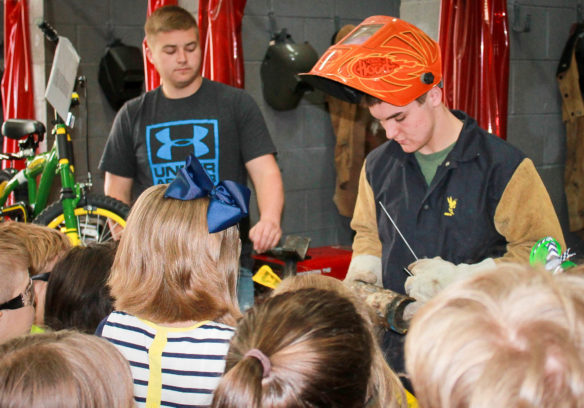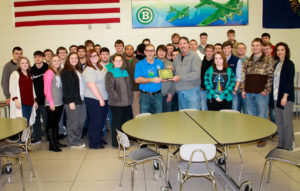
Students in Kevin Chatellier’s welding class at Ballard Memorial High School (Ballard County) demonstrate their work for elementary school students during a College and Career Week event at the district’s career and technical center. Seniors from the high school’s welding, industrial maintenance and agriculture classes were able to take an OSHA 10 safety course that is required by construction and maritime workplaces.
Photo by Julie Thomas
By Mike Marsee
michael.marsee@education.ky.gov
Employers want it, graduates need it and Kevin Chatellier thinks it’s way more valuable than a gun rack.
Chatellier, the welding instructor at Ballard Memorial High School (Ballard County), led a drive to make a U.S. Occupational Safety and Health Administration safety course available free of charge to every senior in the welding, industrial maintenance and agriculture classes at his school.
Thirty-seven students at the school took and passed the OSHA 10 class last fall, which gives them a certification that is required by all construction and maritime workplaces. It also aligns with KDE’s mission to make every student college- and career-ready by bringing these students a step closer to career readiness.
Chatellier would like to see students across the state have the same opportunity to obtain that certification, which is good for life, recognized in every state and required by many employers.
“We call our kids college- and career-ready, but in my opinion, without this OSHA 10 training, they’re not career-ready yet,” Chatellier said.

Robert Sterling, center left, of Iron Workers Local 782, and Kevin Chatellier, center right, the welding instructor at Ballard Memorial High School (Ballard County) stand with seniors from the school’s welding, industrial maintenance and agriculture classes who passed the OSHA 10 safety course. Required by construction and maritime workplaces, the course was offered by the school this year for the first time. Chatellier worked to make the 10-hour course available to Ballard Memorial students and Sterling, an OSHA-certified instructor, taught the course.
Photo submitted
Mary Taylor, an industry training and development specialist in the Kentucky Department of Education’s Office of Career and Technical Education, said there have been discussions about making OSHA 10 available to certain CTE students across the state.
“I just met with a group recently about trying to implement OSHA 10 for CTE construction and manufacturing students statewide,” Taylor said. “This is a very costly process, but I think we are garnering some excellent industry partners to assist.”
Chatellier said he has ideas about how to bring some of those industry partners to the table, starting with organized labor.
The course offered at Ballard Memorial was taught free of charge by Robert Sterling, an OSHA-certified instructor who is also the apprentice coordinator for Iron Workers Local 782, a Paducah-based member of the International Association of Bridge, Structural, Ornamental and Reinforcing Iron Workers.
“One thing that has been brought up is the cost and how to get this done. There’s a lot of organized labor out there. If school instructors are not certified themselves, we have waiting in the wings pipefitters, ironfitters, millwrights, boilermakers. They all have instructors that are more than qualified to teach and they’re more than glad to come into your schools to teach this program,” Chatellier said. “It helps them, too. They’re looking for productive people that are ready to go to work.”
Chatellier said graduates are better prepared for the workforce if they already have taken OSHA 10, a course that OSHA’s website says is intended to improve an entry level construction worker’s general awareness on recognizing and preventing hazards on a construction site.
“This will at least get them into the industry, and once they get their job they will more than likely go on and further their training,” he said. “They will at least go in with a good foundation of safety and employers want that.”
Chatellier said companies are pushing for the OSHA 10 training in an effort to reduce work-related injuries that cost them some $13 billion each year. He said bigger companies can and sometimes do offer it to their employees, but many smaller companies cannot.
“They’re requiring that you have this when you come in or get it on your own,” he said.
It can be a Catch-22, however, because getting certified on your own means spending about $80 that prospective workers just out of school often don’t have.
Chatellier, a former pipefitter who has been teaching for 27 years, believes strongly enough in offering OSHA 10 that he is going to be trained as an OSHA-certified instructor this summer so he can teach the course at Ballard Memorial.
KDE’s Taylor said that may be a good way to get the course in schools across the state at a lower cost.
“The best-case scenario will be for the instructors to take the ‘train-the-trainer’ courses and teach the students at school,” she said.
Other states are trying to do this for their students as well. In Georgia, a 2006 agreement between OSHA, Georgia schools, the Georgia Tech Research Institute and other groups to make safety and health training more available to students has led to the offering of the OSHA 10 course in a growing number of schools, where it is has been team-taught by OSHA and Georgia Tech instructors and industry representatives.
Chatellier said he became convinced of the need for students to be career-ready long before the term became fashionable. He taught in inner-city schools in New Orleans for 14 years, where preparing students for the workplace was a priority.
“My job wasn’t to teach them how to make tables and deer stands and gun racks for pickup trucks, it was to make them work-ready,” he said. “When I came here 12 years ago and started this program, I said, ‘We’re not going to coach the test. We’re not going to work to build hunting equipment. We’re going to help them come out of school ready to be state-certified welders ready to go to work if they choose to.’”
Chatellier said the 37 Ballard Memorial seniors who took the course were excused from their other classes during the two days it was taught there.
“Knowing they were the first class in the state to be offered this,” Chatellier said, “that was exciting to them.”
They might be even more excited if they know what could lie ahead for them. Chatellier said the job market in his area is good and opportunities are there for graduates. He cited a former student who was in the top 10 in his class but needed to go to work rather than go to college. He got into the pipefitters’ union, just completed a five-year apprenticeship and is now making $118,000 per year.
“For those that can’t further their education and need to make a good living, we’ve got to get them good jobs,” Chatellier said.
MORE INFO …
Kevin Chatellier kevin.chatellier@ballard.kyschools.us
Mary Taylor mary.taylor@education.ky.gov



Leave A Comment